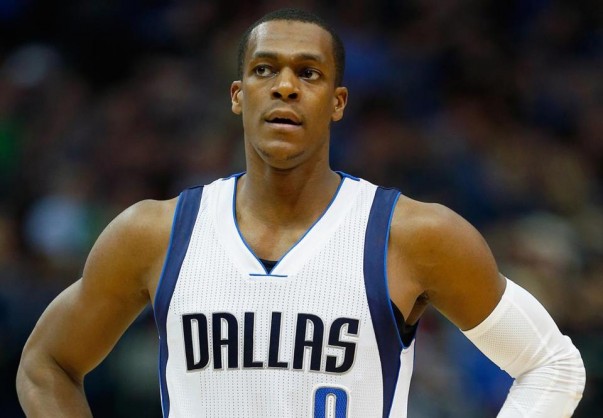Dallas Mavericks head coach Rick Carlisle was as blunt as you could possibly be about the future of guard Rajon Rondo on Wednesday.
Reporter: Do you expect Rondo to wear a Mavericks uniform again?
Carlisle: Uhhhh, no, I don’t.
He went on to say in regard to the injury news released about Rondo (who is out indefinitely with a back injury), “I understand the announcement that’s been made is going to have different interpretations. I’m giving you our interpretation of it and this is fact. “
Whether the second statement from Carlisle is true or not, it was abundantly clear after Game 2 of their first-round series against the Houston Rockets that the Mavs were better off without their starting point guard.
Rondo played just under 10 minutes, the least amount of run he’s seen in 94 playoff appearances. He was benched 34 seconds into the second half after a stretch that included two personal fouls and a technical. In the first half, Rondo committed an unforced eight-second violation.
In the two Dallas losses in this series, the Mavericks are a -36 in the 37 minutes he’s played, and a +14 in the 59 minutes he’s sat.
Here’s a visual based on offensive rating and defensive rating from the NBA’s media website to further illustrate the splits:
When you add in the offensive drop-off during the regular season, the conclusion that the Rondo experiment in Dallas was a failure is a fair one to make.
So why did it all fall apart?
Tyson Chandler, Dirk Nowitzki, and Chandler Parsons are a frontcourt that conceptually makes sense around Rondo. Chandler was your dive man in the pick and roll who didn’t need the ball. Nowitzki and Parsons can both space the floor with their jumpers and be secondary ball handlers.
The biggest issue emerged with Rondo’s backcourt mate Monta Ellis. He and Rondo are both guards who need the ball in their hands and should be paired with someone who has the ability to catch and shoot.
According to SportVU, Ellis shot 32.4 percent overall in catch-and-shoot situations and 29.4 percent from three. Rondo came in at 34.9 percent overall and 34 percent from three.
In the 1,021 minutes these two spent on the court together, the most for Rondo and any Dallas teammate, they were a -1.5 net rating.
In the 539 minutes Ellis was paired with Jameer Nelson this season, Dallas had a +10.5 net rating. Nelson isn’t a better player than Rondo (maybe he is), but he fit with what Ellis does best.
Lineup construction aside, the next question that needs to be asked is this: Is Rondo even a good player anymore?
The fact I had to wonder if he’s an improvement relative to Jameer Nelson shows that, first of all, the above question is more than legitimate. Second, it shows that the answer to the above question might very well be “no.”
*
In the first eight years of his career, Rondo averaged three free throw attempts per 36 minutes and shot 62 percent from the charity stripe. This season the free throw attempts dropped to 1.4 per game, and the percentage dove all the way down to slightly under 40 percent.
It’s pretty clear the free throw percentage has an impact on how he plays offensively, but the trend of Rondo’s shot locations has been going in the wrong direction for some time. According to Basketball Reference, during the first five years of his career, the average distance of Rondo’s shots was 8.3 feet. Nearly 48 percent of his attempts came between zero and three feet from the basket. During the last three seasons the average shot distance has increased to 11.2 feet, and only 34.5 percent of his attempts are coming between zero and three feet.
That doesn’t work for someone whose game is about dribble penetration and setting up teammates for threes or layups.
Luckily for Dallas, it did not break up a championship contender to acquire Rondo. Yes, the Mavericks moved two useful rotation players, but those players weren’t going to send this roster over the top. It also needs to be noted there was no guarantee Brandan Wright or Jae Crowder were going to be around with the Mavs long term – Wright is an unrestricted free agent this summer and Crowder is a restricted one. The 2015 first round pick stings a bit, but at least it’s a late pick.
Mark Cuban and company can rebound from this if they put together a strong offseason plan.
The same might not be true for Rondo.
*
Right now, Rondo’s name is being connected in free agency to the Lakers and Knicks, but both of these teams are terrible fits. A backcourt pairing with Kobe Bryant or the Knicks’ hybrid triangle-based system (which averaged the second most passes per game in NBA) don’t seem like matches to Rondo’s skills. Moreover, I’m not sure there is any team in the league which does stand out as a fit for him.
Because of Rondo’s limited skill set — it puts a low ceiling on his level of versatility — you essentially need to construct an entire roster around him to accentuate his positives. Sadly, those pluses aren’t worth the investment of doing that, at least not anymore.
Rajon Rondo had a splendid NBA career that saw him help the Boston Celtics win an NBA championship and get to the NBA Finals on another occasion. His time in this league will hopefully be remembered more for the successes he had than for his recent — and most likely continued — downfall.

